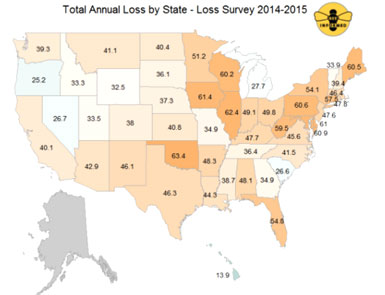The environmental community has been pushing hard to get EPA to better regulate – if not ban – pesticides that are leading to the collapse of pollinator, plant and animal populations, so far to no avail.
But now, the EPA will analyze the effects of atrazine, propazine, simazine and glyphosate – the most commonly used pesticides – on 1500 endangered plants and animals across the country. It will complete the assessment by June 2020, as part of a settlement with the Center for Biological Diversity.
"This settlement is the first step to reining in the widespread use of dangerous pesticides that are harming both wildlife and people," says Brett Hartl at the Center. "Atrazine, for instance, chemically castrates frogs even in tiny doses, is an endocrine disruptor, and likely causes birth defects in people. The EPA should have banned this years ago."
Up to 300 million pounds of these pesticides are dumped on US crops every year. The World Health Organization recently declared glyphosate (Monsanto’s Roundup) a "probably human carcinogen," and is strongly linked to the massive declines in bees and monarch butterflies.

The last time EPA evaluated ecological impacts of glyphosate was in 1993, when only 10 million pounds were applied a year.
Even worse, for decades, EPA has continued to register and allow the use of pesticides without considering their impacts on endangered (and all species), despite being legally required to do so.
Recently, EPA announced an anemic fix to the pesticide problem, proposing temporary "pesticide-free zones" for commercial crops. Farmers can’t spray when crops are in bloom and bees have been trucked in to pollinate them. Nice idea – don’t dump pesticides on plants that bees are pollinating!
Even this small step falls short. Besides only applying to commercially-used bees, it doesn’t address the widespread industry practice of treating seeds with these pesticides.
The Fish and Wildlife Service (FWS) also uses pesticides on National Wildlife Refuges, and now has to evaluate five pesticides because of legal action by the Center.
FWS launched the Monarch Conservation Fund to restore 200,000 acres of critical habitat over the next three years, to keep them off the Endangered Species List.
Massive Action for Pollinators Underway
When the conclusive connection between neonic pesticides and pollinator collapse became clear, Friends of the Earth found that 51% of wildflowers sold at big retailers like Home Deport, Lowe’s and Walmart contained pesticide levels that could harm or kill bees.
Since the word got out, retailers and wholesale nurseries have been responding, says Friend of the Earth after conducting a survey. Home Depot, BJ’s, Lowe’s, and Whole Foods are labeling these plants and phasing out neonic pesticides from being sold in their stores. The average homeowner uses half the neonics sprayed in the US. Some nurseries have moved to organic practices to grow plants, realizing they don’t need to use pesticides at all.

What was EPA’s response? Add labels to pesticides that describes how it affects bees, urging precaution. EPA says it won’t ban the pesticides – as Europe has done – because there are a "complex set of factors" negatively impacting bees. That’s why EPA is going to court. Ontario beekeepers are taking manufacturers to court.
In Oregon, Eugene and Portland voted to ban the use of neonics.
Million Pollinator Garden Challenge
This month, The Pollinator Partnership launched the Million Pollinator Garden Challenge, with a goal of 1 million more pollinator gardens by the end of 2016.
Habitats of every size counts, from window boxes to school gardens (of which there are 15,000), from home gardens to golf courses, and corporate and university campuses, they say.
Last year, they began enrolling farms to plant bee buffers and almost every state wants in. The White House strategy is to restore 7 million acres of pollinator habitat through the Pollinator Partnership over the next five years, and to increase monarch butterflies to 225 million in their Mexico wintering grounds by then.
But the strategy ignores the very agricultural practices that cause the problem in the first place. The Organic Trade Association wants the White House to officially recognize organic farming practices as beneficial to pollinators.
"It’s time our policymakers recognize organic’s contribution to our pollinator population, and officially make organic a part of the solution. Organic farming alleviates many threats to bees and other pollinators by not using synthetic pesticides and supporting biodiversity and the habitat of pollinators," says Melissa Hughes of Organic Valley and president of OTA’s Board.
The Highways BEE Act has been introduced in the Congress, which directs the Secretary of Transportation to work with willing state agencies to create pollinator habitat along highway right-of-ways, instead of spending all that money to mow grass.
++++
Urge EPA to revise and expand its rule to protect all bees and to regulate seeds, not just foliar spraying:
